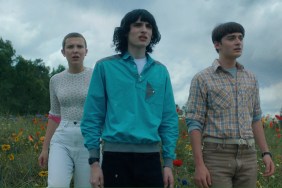Synthwave Stranger Things soundtrack is a dark, moody masterpiece
The nostalgic ‘80s film and music tsunami is still crashing all over the contemporary pop culture landscape, with a new generation of creators apparently fascinated by the stuff that their dads (or, er young Uncles, um, older cousins, um…damn, I’m old…) grooved on without any affectation.
The cynic can sneer at this quasi-hipster appreciation of the shallow “me” decade that chased the sex and danger-dripping 1970s. It’s easy to laugh at the fetishized filter the next generation drapes over the previous, but truthfully, with the advent of the rock video, the progression of electronic music and the obsession with slick visuals and style over substance, the ‘80s really were an aesthetically pleasing period.
The creators of Netflix’s much buzzed series Stranger Things are fully completely aware and in love with that aesthetic and the show is nothing save a living, breathing, heaving amalgam of vintage Spielberg kid-centric adventures (E.T., The Goonies, Gremlins), the teen-crush fables of John Hughes (Pretty in Pink, Sixteen Candles) and harder-edged John Carpenter joints. The latter element is of particular import as Stranger Things’ soundtrack is an often verbatim quote on Carpenter’s signature analog/electro soundtrack groove.
RELATED: Read Our Interview with Stranger Things’ Shawn Levy
One can truly appreciate the show’s soundtrack now that Lakeshore Records have released the digital version of the original Stranger Things music (the CD will follow on September 16th with a second volume appearing on September 23rd). The score is composed by Kyle Dixon and Michael Stein, members of the Austin based synthwave act S U R V I V E; one listen and you realize just how vital that music is to the show’s identity.
Right from the first track, the slowly-turning-iconic theme, you can hear the palpable Carpenter influence (particularly Big Trouble in Little China) but there’s also hints of the German synth collective Tangerine Dream (Near Dark, Thief). “Friendship” is warm and progressive, recalling ambient electronic acts like Boards of Canada and Aphex Twin; it’s moody and sweet and perfectly captures the dynamic of the show’s central young heroes. “The Upside Down” is minimal and almost new age, with a distinct Vangelis flavor, recalling the Blade Runner score but less cosmic, more earthy.
RELATED: Read Our Discussion of the Blade Runner Soundtrack
Some of the score is actively frightening, with “Hallucinations” discordant notes echoing the haunting avant garde soundscapes of the Climax Golden Twins music for Brad Anderson’s Session 9. The Tangerine Dream vibe continues on tracks like “Biking to School” which hints at the music for ’80s sex comedy classic Risky Business.
There’s also the vibe of contemporary composers like Cliff Martinez here and many of the cues sound like outtakes of his score for Nicolas Winding Refn’s Drive.
About the score, Stein said “We discussed having a classic tone and feel to the music for the show but being reserved enough that it wasn’t ’80s cheese, while offering a refreshing quality so that felt modern. This was one of the qualities that drew them to our music in the first place. Having a familiarity with classic synths worked, but with an overall forward thinking approach.”
This quote both exemplifies the power of the score and the power of the show. It’s “retro”, sure. A period piece that offers an impression of a time and place but it also feels fresh and innovative. And the soundtrack, like all great soundtracks, stands alone, powerful without the accompaniment of the visuals that it was sculpted for.
Go to the Lakeshore Records site now for more info and ordering instructions.










